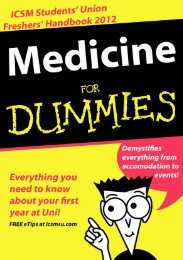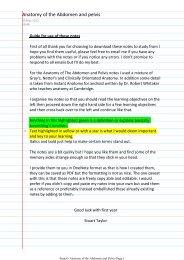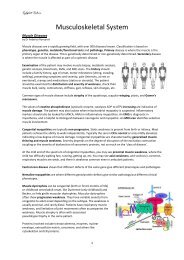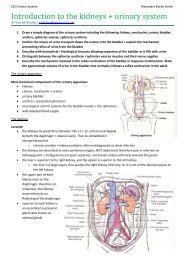1. Introduction to Medical Sociology
1. Introduction to Medical Sociology
1. Introduction to Medical Sociology
You also want an ePaper? Increase the reach of your titles
YUMPU automatically turns print PDFs into web optimized ePapers that Google loves.
FOCP Alexandra Burke-Smith<br />
� The patient will be concerned mainly with their own symp<strong>to</strong>ms; and their perspective will be coloured by the<br />
material, cultural and inter-personal context in which their symp<strong>to</strong>ms have developed.<br />
� The doc<strong>to</strong>r will be concerned with their whole work load i.e. the present patient plus all the other patients<br />
waiting <strong>to</strong> be seen; and their perspective will be coloured by their professional training and socialisation.<br />
� In consequence, successful communication during a consultation can be difficult <strong>to</strong> achieve. Doc<strong>to</strong>rs need <strong>to</strong><br />
understand these problems, because successful communication can influence their clinical effectiveness<br />
Clinical Effectiveness<br />
The quality of communication between a doc<strong>to</strong>r and patient influences the exchange of information between them<br />
and the patient's satisfaction with the doc<strong>to</strong>r; both can affect the doc<strong>to</strong>r's clinical effectiveness.<br />
� Information exchange:<br />
- Accuracy and completeness of the diagnosis<br />
- Physiological response <strong>to</strong> therapy, e.g. Egbert's experiment on communication, lowering of anxiety and the<br />
need for analgesia and speed of recovery after surgery<br />
- Practicality of the treatment regime<br />
� Patient Satisfaction<br />
- Effectiveness of therapy, e.g. placebo effect<br />
- Compliance with medical advice e.g. 30% of prescribed drugs are either not taken or taken<br />
incorrectly; non-compliance with preventative advice is higher still<br />
- Future illness behaviour and the doc<strong>to</strong>r’s effectiveness as a medical educa<strong>to</strong>r<br />
Balance of power<br />
His<strong>to</strong>rically power has shifted between doc<strong>to</strong>r and patient; as medicine becomes more specialised, shift of power<br />
<strong>to</strong>wards doc<strong>to</strong>r. However medical paternalism clashes with patient au<strong>to</strong>nomy, therefore the power shifts back<br />
<strong>to</strong>wards patient. The balance of power between doc<strong>to</strong>r and patient depends upon:<br />
� Patient’s clinical status<br />
The Szasz-Hollender typology, as amended by Friedson, describes four clinical levels:<br />
- unconscious or anaesthetised<br />
- acutely ill<br />
- managing a chronic disease<br />
- healthy patient requesting assistance<br />
Each has a correspondingly appropriate DPR:<br />
- activity-passivity/paternalistic<br />
- guidance-co-operation<br />
- mutual participation<br />
� Setting of the consultation<br />
- number of staff present<br />
- whether patient undressed or in bed<br />
- patient alone<br />
- depends whether GP, Hospital, surgeon etc<br />
- symbols of authority- white coat, stethoscope etc<br />
10







